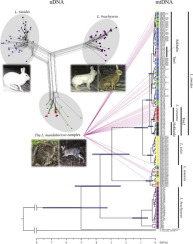Molecular Phylogenetics and Evolution ( IF 3.6 ) Pub Date : 2019-04-02 , DOI: 10.1016/j.ympev.2019.04.003 Gohta Kinoshita , Mitsuo Nunome , Alexey P. Kryukov , Irina V. Kartavtseva , San-Hoon Han , Fumio Yamada , Hitoshi Suzuki

|
Hares of the genus Lepus are distributed worldwide, and introgressive hybridization is thought to be pervasive among species, leading to reticulate evolution and taxonomic confusion. Here, we performed phylogeographic analyses of the following species of hare across East Asia: L. timidus, L. mandshuricus, L. coreanus, and L. brachyurus collected from far-eastern Russia, South Korea, and Japan. Nucleotide sequences of one mitochondrial DNA and eight nuclear gene loci were examined, adding sequences of hares in China from databases. All nuclear DNA analyses supported the clear separation of three phylogroups: L. timidus, L. brachyurus, and the L. mandshuricus complex containing L. coreanus. On the other hand, massive mitochondrial introgression from two L. timidus lineages to the L. mandshuricus complex was suggested in continental East Asia. The northern population of the L. mandshuricus complex was mainly associated with introgression from the continental lineage of L. timidus, possibly since the last glacial period, whereas the southern population of the L. mandshuricus complex experienced introgression from another L. timidus lineage related to the Hokkaido population, possibly before the last glacial period. In contrast to continental hares, no evidence of introgression was found in L. brachyurus in the Japanese Archipelago, which showed the oldest divergence amongst East Asian hare lineages. Our findings suggest that glacial–interglacial climate changes in the circum-Japan Sea region promoted distribution shifts and introgressive hybridization among continental hare species, while the geographic structure of the region contributed to long-term isolation of hares on the islands, preventing inter-species gene flow.






























 京公网安备 11010802027423号
京公网安备 11010802027423号